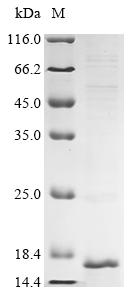Recombinant Human Prostaglandin D2 receptor (PTGDR) , partial
CAT:
399-CSB-EP621658HU1-03
Size:
1 mg
Price:
Ask
- Availability: 24/48H Stock Items & 2 to 6 Weeks non Stock Items.
- Dry Ice Shipment: No




Recombinant Human Prostaglandin D2 receptor (PTGDR) , partial
- CAS Number: 9000-83-3
- Gene Name: PTGDR
- UniProt: Q13258
- Expression Region: 217-262aa
- Organism: Homo sapiens
- Target Sequence: CNLGAMRNLYAMHRRLQRHPRSCTRDCAEPRADGREASPQPLEELD
- Tag: N-terminal 10xHis-tagged and C-terminal Myc-tagged
- Source: E.coli
- Field of Research: Signal Transduction
- Assay Type: Developed Protein
- Relevance: Receptor for prostaglandin D2 (PGD2). The activity of this receptor is mainly mediated by G (s) proteins that stimulate adenylate cyclase, resulting in an elevation of intracellular cAMP. A mobilization of calcium is also observed, but without formation of inositol 1, 4, 5-trisphosphate. Involved in PLA2G3-dependent maturation of mast cells. PLA2G3 is secreted by immature mast cells and acts on nearby fibroblasts upstream to PTDGS to synthesize PGD2, which in turn promotes mast cell maturation and degranulation via PTGDR.
- Purity: Greater than 90% as determined by SDS-PAGE.
- Activity: Not Test
- Length: Partial
- Form: Liquid or Lyophilized powder
- Buffer: If the delivery form is liquid, the default storage buffer is Tris/PBS-based buffer, 5%-50% glycerol. If the delivery form is lyophilized powder, the buffer before lyophilization is Tris/PBS-based buffer, 6% Trehalose, pH 8.0.
- Reconstitution: We recommend that this vial be briefly centrifuged prior to opening to bring the contents to the bottom. Please reconstitute protein in deionized sterile water to a concentration of 0.1-1.0 mg/mL.We recommend to add 5-50% of glycerol (final concentration) and aliquot for long-term storage at -20℃/-80℃. Our default final concentration of glycerol is 50%. Customers could use it as reference.
- Molecular Weight: 12.8 kDa
- References & Citations: "Selective inhibition of heterotrimeric Gs signaling. Targeting the receptor-G protein interface using a peptide minigene encoding the Galpha (s) carboxyl terminus." Feldman D.S., Zamah A.M., Pierce K.L., Miller W.E., Kelly F., Rapacciuolo A., Rockman H.A., Koch W.J., Luttrell L.M. J Biol Chem 277:28631-28640 (2002)
- Storage Conditions: The shelf life is related to many factors, storage state, buffer ingredients, storage temperature and the stability of the protein itself. Generally, the shelf life of liquid form is 6 months at -20℃/-80℃. The shelf life of lyophilized form is 12 months at -20℃/-80℃.
